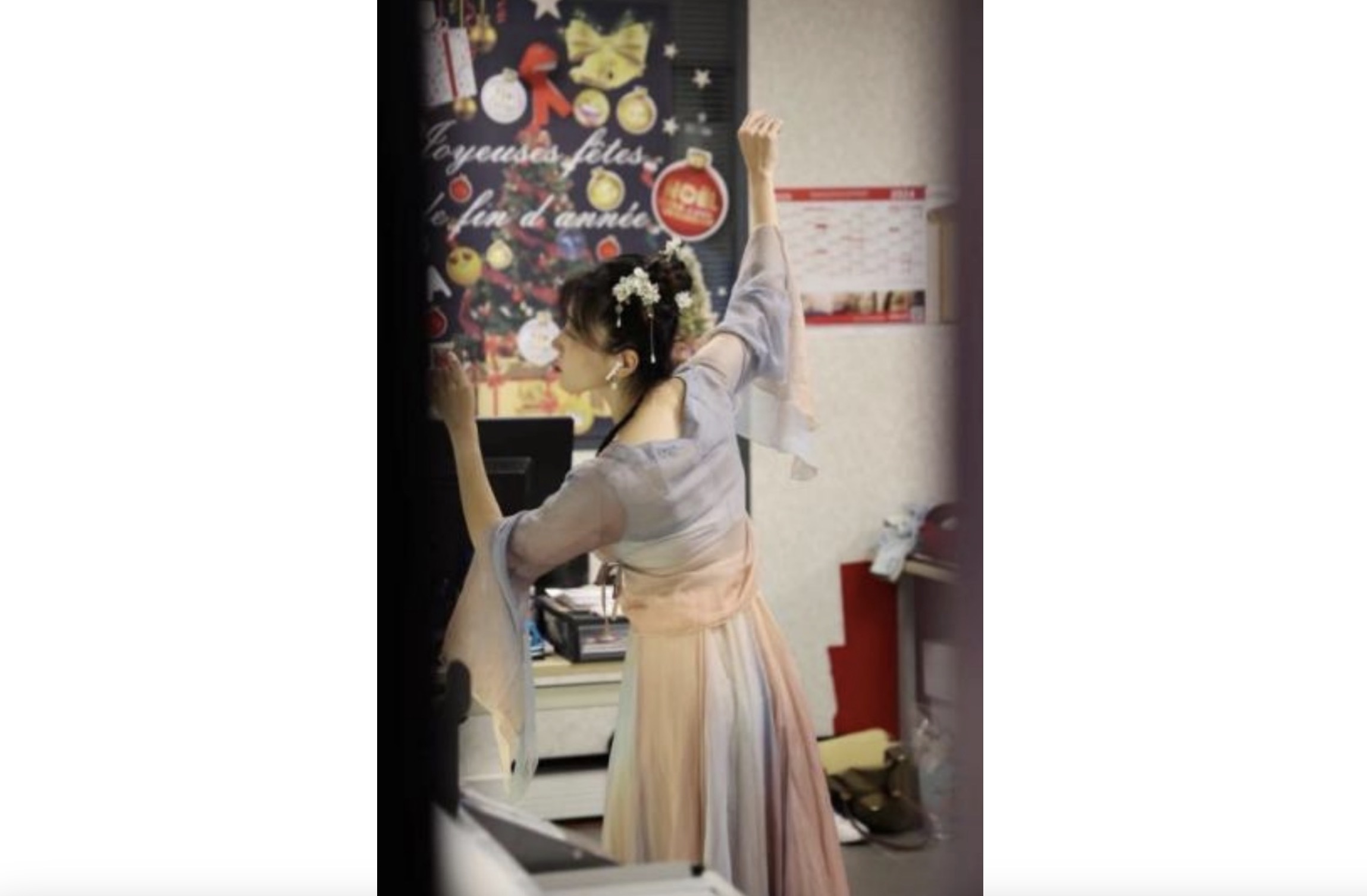Press Contact
SISU News Center, Office of Communications and Public Affairs
Tel : +86 (21) 3537 2378
Email : news@shisu.edu.cn
Address :550 Dalian Road (W), Shanghai 200083, China
Boyan Hanfu Association in France (4): Weaving Cultural Threads Beyond Borders
18 October 2024 | By SISU Global | SISU/Jiao Junpeng, Lu Zhi Yi/Vieira
The Beauty of Hanfu Amid Financial Struggles
It’s not just French members like Solange who are captivated by Hanfu; many Chinese members are drawn to Boyan for the same reason.
Xie, now in her forties, candidly admitted that it was the sheer beauty of Hanfu that motivated her to join. While waiting backstage during performances, she seizes every free moment to pose in signature dance moves, letting photographers capture her in Hanfu.
Her teammate, Qi Momo, also a Hanfu enthusiast, joined the association after being captivated by Boyan’s Hanfu photos on social media.
According to Zhong, Boyan owns about 1,000 sets of Hanfu, which are stored in two rented warehouses.
Both Xie and Qi are avid collectors of Hanfu, paying close attention to design and historical accuracy. “For casual wear or regular performances, the style can be flexible, but for important events, it has to be historically correct,” Xie said.
For this commercial performance, they chose the cheapest Hanfu available from Chinese online stores. Despite the lower quality of the design and material, the total cost, including headpieces and accessories, still reached 600-700 yuan per set after shipping to France.
Due to the association’s financial strain, performers receive only a small payment for commercial shows, and they have to cover the upfront cost of costumes themselves. Xie noted that beyond regular classes, there’s no longer enough funding to rent space for extra dance rehearsals.
“The association faces financial challenges almost daily,” said Zhong. “As a non-profit, we can’t generate much income, and at our worst, I’ve barely been able to pay the rent.”
“The annual membership fee is just 25 euros, allowing members to join major events and learn traditional arts like Kunqu opera and classical dance, but it’s far from enough to cover Boyan’s significant operational costs,” she said.
With frequent large-scale events, the expenses are huge. “We cover everything—guest fees, volunteer meals, venue rentals, logistics, insurance, and transportation costs, even banners and posters. For a non-profit, it’s a heavy burden,” Zhong explained.
“When financial crises hit, I’ve had to dip into my own pocket to keep the association running,” she admitted.
Despite these challenges, Boyan has yet to find a solution to its financial struggles. The French government helps by offering venues, and corporate sponsors contribute some funding, but this only eases part of the burden.
“While venue costs are covered, other expenses still weigh us down,” Zhong said.

Qi Momo is reviewing her dance moves in the staff office before taking the stage.
“We’re not in this for the money—it’s all about passion,” Xie said. To cut costume costs, they make the most of their performances. Xie explained that when clients like Carrefour request two dances, they send videos of past performances and suggest a mix, such as pairing an energetic dance with a more graceful one. “Since we’ve already invested in the costumes, we work hard to promote the performances and recoup the costs,” she said.
When Zhong first founded the association, Hanfu culture in China was still in its early stages. She believes the Hanfu revival began during the 2003 APEC summit when Chinese leaders wore Tang suit, a modernized outfit inspired by the Qing Dynasty's mandarin jacket, featuring a stand-up collar and Western tailoring techniques.
“People then realized that our core identity is rooted in Han civilization. We are Han people (the ethnic majority in China), so we should be wearing Hanfu (fu means clothing),” Zhong said, considering herself among the first wave of Hanfu revivalists. “In the beginning, Hanfu was seen as something for young people to play dress-up with, but our generation saw it as something worthy of revival and reinvention.”
After earning her PhD in Industrial Engineering, Zhong became a company representative in France. However, as Boyan grew, she said, “Running the association became as demanding as a full-time job. There’s barely time to rest, and almost every day requires a decision.” To manage the growing workload, she reduced her job to part-time, dedicating more time and energy to the association.
Zhong sees running a large non-profit as a true "labor of love," requiring a careful balance of time, energy, and life commitments. "It all comes down to having a sense of mission and responsibility," she said. "Ultimately, it’s about whether you believe in reviving and promoting Chinese culture abroad. If you think it’s worth it, that’s what drives you."
"People only give you the chance to spread Chinese culture when they recognize its value and see that you’re doing it well," She said.
Zhong noted that over time, many of the founding members have gradually stepped back from their core roles. "A lot of people are still with the group, but they’re less active now, feeling they have other priorities. They still support us and join events occasionally, but they’re no longer the driving force."
"This is natural," she said. "It’s the way of life—some will move on, but there will always be those who stay committed."
Press Contact
SISU News Center, Office of Communications and Public Affairs
Tel : +86 (21) 3537 2378
Email : news@shisu.edu.cn
Address :550 Dalian Road (W), Shanghai 200083, China

